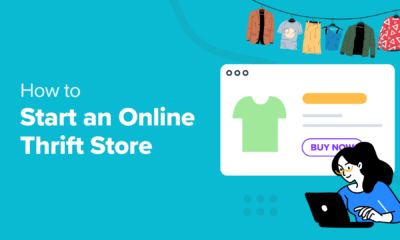SEO
Online brand protection: trusted automated monitoring is key

Even though consumers enjoy having the world at their fingertips, they have become all too aware of how much their personal data is abused. According to the Nielsen 2021 Trust in Advertising Survey, 36 percent of respondents distrust ads on social networks, while 36 percent distrust ads served in search engine results.
“As people more frequently shop online, they’ve realized the top ads are not necessarily the best option,” says Josh Stephens, director of Digital Marketing at CWT, one of the biggest travel companies worldwide. “If consumers do not recognize the company name, they will not pay attention, so the ads are becoming a sort of screen blind spot.”
Daniel Creed, head of marketing, planning and effectiveness at Santander UK adds: “As media (particularly online and social channels) attracts increasing public scrutiny and politicization, brands increasingly risk becoming embroiled in controversy seemingly by their mere presence on a given platform at the wrong time.”
Fraudulent behaviour
It is therefore critical all businesses ensure their branding, advertising, and marketing practice integrity, whilst also protecting themselves against the maleficence of advertising fraud.
The unauthorised use of a company’s intellectual property by a third party can create confusion with the customer base, and prospects in terms of business offering, financial model, and a company’s values.
Advertising fraud has become an unintended by-product of the digital era, and left unchecked, can become increasingly rampant. Take affiliate marketing for example – a successful strategy used by digitally-savvy companies but has its own risks.
Affiliate marketing
Even for well-known companies, working with affiliates helps them to tap into audiences outside their traditional channels. Affiliates provide brands and marketers with the opportunity to reach and engage their target audience, creating not only an opportunity for acquisition, but also the opportunity to develop long term relationships with their audiences because of a trusted introduction and recommendation.
However, where traditional channels and affiliates often collide is in paid search, necessitating monitoring to prevent cross-channel cannibalization. “Brands today have become very adept at using paid search as a source of high intent traffic – particularly branded search,” says explains Van Chappell, general manager at BrandVerity, a US-headquartered company which provides paid search and affiliate monitoring tools.
He notes that when affiliates also appear on a search engine’s results page, they “compete” with the brands paid search team, driving up the cost of that traffic. “It is also unlikely that traffic from branded search is incremental to traffic the brand would get anyway,” Chappell says.
Chappell also says that “ad hijacks” sometimes occur. “We see affiliates which copy the ads already utilized by brands,” he says. “The consumer types in a search term, they see a search result and it looks like the brand they were looking for – they click on the ad, and it will take them to the site, and so to the user, everything’s fine.”
Behind the scenes
Everything, however, is not fine. Even though the brand will ultimately win the sale, this detour on the consumer journey bears a greater cost for the company. This is because the commission paid to an affiliate is considerably more than the CPC a paid search team pays to a search engine.
There is also an underlying cost to a company’s reputation among affiliates and, ultimately, their brand. “The affiliate channel is very important for brands; it’s a great marketing channel because it is performance based,” Chappell says.
“Affiliate managers, agencies and OPMs spend a lot of time cultivating these relationships and making these connections between publishers that come up with really interesting ways to reach consumers and the brands where those consumers then make purchases.”
Chappell adds a poor reputation “drives quality publishers away”. “It’s damaging for the channel and makes it much harder to have a successful affiliate programme,” he says.
When a brand has a clean and well run affiliate channel in place, it attracts the best partners, which promotes the brand and enables it to reach new audiences.
Chappell expands on the benefits further: “In many ways, some of these techniques [in affiliate fraud] can lead to distraction and lead you to places that you didn’t intend to go. If a brand can keep the search engine clean of all these distractions, the consumer clearly knows where they can go to do what they wanted. It’s a better experience for consumers.”
Keep it clean
Santander’s Creed believes it is not the customers’ responsibility to make the distinction between a platform getting it wrong and brands not taking precautions.
“The onus is on brands to ensure they are making informed decisions and are taking the necessary steps to mitigate and minimise these risks,” he says. “Brands need to understand the risks attendant to each media channel and develop a comprehensive policy for the protection of their brand and evolve the right tactics to protect themselves.”
To maintain a clean affiliate model, companies must monitor their affiliates. There are two ways to do this: manual monitoring and automated monitoring.
The former, for example, involves an affiliate manager typing branded or non-branded keywords into a search engine and monitoring the adverts which appear.
There are numerous challenges to this approach, however. Not only is it time-consuming, but it is also arguably ineffective given fraudulent adverts often look identical to their genuine counterparts. It is also impossible to capture varying search engine results from just one location using manual monitoring.
Automated monitoring, on the other hand, means all associated affiliates are monitored from one place around the clock. If a false advert appears, brands can crackdown on unsavoury partners quickly, while protecting the customer journey and keeping their marketing budget intact.
In doing so, the brand reputation remains intact which helps them to attract the most successful affiliates. This in turn further promotes the brand in a virtuous cycle that continues to feed upon itself.
Marketing in the digital era promises boundless opportunities, but brand protection is more complex than ever. Fortunately, with the right tools in place, the results become clear.
Source link
SEO
Google Declares It The “Gemini Era” As Revenue Grows 15%

Alphabet Inc., Google’s parent company, announced its first quarter 2024 financial results today.
While Google reported double-digit growth in key revenue areas, the focus was on its AI developments, dubbed the “Gemini era” by CEO Sundar Pichai.
The Numbers: 15% Revenue Growth, Operating Margins Expand
Alphabet reported Q1 revenues of $80.5 billion, a 15% increase year-over-year, exceeding Wall Street’s projections.
Net income was $23.7 billion, with diluted earnings per share of $1.89. Operating margins expanded to 32%, up from 25% in the prior year.
Ruth Porat, Alphabet’s President and CFO, stated:
“Our strong financial results reflect revenue strength across the company and ongoing efforts to durably reengineer our cost base.”
Google’s core advertising units, such as Search and YouTube, drove growth. Google advertising revenues hit $61.7 billion for the quarter.
The Cloud division also maintained momentum, with revenues of $9.6 billion, up 28% year-over-year.
Pichai highlighted that YouTube and Cloud are expected to exit 2024 at a combined $100 billion annual revenue run rate.
Generative AI Integration in Search
Google experimented with AI-powered features in Search Labs before recently introducing AI overviews into the main search results page.
Regarding the gradual rollout, Pichai states:
“We are being measured in how we do this, focusing on areas where gen AI can improve the Search experience, while also prioritizing traffic to websites and merchants.”
Pichai reports that Google’s generative AI features have answered over a billion queries already:
“We’ve already served billions of queries with our generative AI features. It’s enabling people to access new information, to ask questions in new ways, and to ask more complex questions.”
Google reports increased Search usage and user satisfaction among those interacting with the new AI overview results.
The company also highlighted its “Circle to Search” feature on Android, which allows users to circle objects on their screen or in videos to get instant AI-powered answers via Google Lens.
Reorganizing For The “Gemini Era”
As part of the AI roadmap, Alphabet is consolidating all teams building AI models under the Google DeepMind umbrella.
Pichai revealed that, through hardware and software improvements, the company has reduced machine costs associated with its generative AI search results by 80% over the past year.
He states:
“Our data centers are some of the most high-performing, secure, reliable and efficient in the world. We’ve developed new AI models and algorithms that are more than one hundred times more efficient than they were 18 months ago.
How Will Google Make Money With AI?
Alphabet sees opportunities to monetize AI through its advertising products, Cloud offerings, and subscription services.
Google is integrating Gemini into ad products like Performance Max. The company’s Cloud division is bringing “the best of Google AI” to enterprise customers worldwide.
Google One, the company’s subscription service, surpassed 100 million paid subscribers in Q1 and introduced a new premium plan featuring advanced generative AI capabilities powered by Gemini models.
Future Outlook
Pichai outlined six key advantages positioning Alphabet to lead the “next wave of AI innovation”:
- Research leadership in AI breakthroughs like the multimodal Gemini model
- Robust AI infrastructure and custom TPU chips
- Integrating generative AI into Search to enhance the user experience
- A global product footprint reaching billions
- Streamlined teams and improved execution velocity
- Multiple revenue streams to monetize AI through advertising and cloud
With upcoming events like Google I/O and Google Marketing Live, the company is expected to share further updates on its AI initiatives and product roadmap.
Featured Image: Sergei Elagin/Shutterstock
SEO
brightonSEO Live Blog

Hello everyone. It’s April again, so I’m back in Brighton for another two days of Being the introvert I am, my idea of fun isn’t hanging around our booth all day explaining we’ve run out of t-shirts (seriously, you need to be fast if you want swag!). So I decided to do something useful and live-blog the event instead.
Follow below for talk takeaways and (very) mildly humorous commentary. sun, sea, and SEO!
SEO
Google Further Postpones Third-Party Cookie Deprecation In Chrome

Google has again delayed its plan to phase out third-party cookies in the Chrome web browser. The latest postponement comes after ongoing challenges in reconciling feedback from industry stakeholders and regulators.
The announcement was made in Google and the UK’s Competition and Markets Authority (CMA) joint quarterly report on the Privacy Sandbox initiative, scheduled for release on April 26.
Chrome’s Third-Party Cookie Phaseout Pushed To 2025
Google states it “will not complete third-party cookie deprecation during the second half of Q4” this year as planned.
Instead, the tech giant aims to begin deprecating third-party cookies in Chrome “starting early next year,” assuming an agreement can be reached with the CMA and the UK’s Information Commissioner’s Office (ICO).
The statement reads:
“We recognize that there are ongoing challenges related to reconciling divergent feedback from the industry, regulators and developers, and will continue to engage closely with the entire ecosystem. It’s also critical that the CMA has sufficient time to review all evidence, including results from industry tests, which the CMA has asked market participants to provide by the end of June.”
Continued Engagement With Regulators
Google reiterated its commitment to “engaging closely with the CMA and ICO” throughout the process and hopes to conclude discussions this year.
This marks the third delay to Google’s plan to deprecate third-party cookies, initially aiming for a Q3 2023 phaseout before pushing it back to late 2024.
The postponements reflect the challenges in transitioning away from cross-site user tracking while balancing privacy and advertiser interests.
Transition Period & Impact
In January, Chrome began restricting third-party cookie access for 1% of users globally. This percentage was expected to gradually increase until 100% of users were covered by Q3 2024.
However, the latest delay gives websites and services more time to migrate away from third-party cookie dependencies through Google’s limited “deprecation trials” program.
The trials offer temporary cookie access extensions until December 27, 2024, for non-advertising use cases that can demonstrate direct user impact and functional breakage.
While easing the transition, the trials have strict eligibility rules. Advertising-related services are ineligible, and origins matching known ad-related domains are rejected.
Google states the program aims to address functional issues rather than relieve general data collection inconveniences.
Publisher & Advertiser Implications
The repeated delays highlight the potential disruption for digital publishers and advertisers relying on third-party cookie tracking.
Industry groups have raised concerns that restricting cross-site tracking could push websites toward more opaque privacy-invasive practices.
However, privacy advocates view the phaseout as crucial in preventing covert user profiling across the web.
With the latest postponement, all parties have more time to prepare for the eventual loss of third-party cookies and adopt Google’s proposed Privacy Sandbox APIs as replacements.
Featured Image: Novikov Aleksey/Shutterstock
-

 PPC7 days ago
PPC7 days ago19 Best SEO Tools in 2024 (For Every Use Case)
-
SEARCHENGINES6 days ago
Daily Search Forum Recap: April 19, 2024
-
SEARCHENGINES7 days ago
Daily Search Forum Recap: April 18, 2024
-

 WORDPRESS6 days ago
WORDPRESS6 days agoHow to Make $5000 of Passive Income Every Month in WordPress
-

 SEO6 days ago
SEO6 days ago25 WordPress Alternatives Best For SEO
-

 WORDPRESS5 days ago
WORDPRESS5 days ago13 Best HubSpot Alternatives for 2024 (Free + Paid)
-

 WORDPRESS6 days ago
WORDPRESS6 days ago7 Best WooCommerce Points and Rewards Plugins (Free & Paid)
-

 MARKETING6 days ago
MARKETING6 days agoBattling for Attention in the 2024 Election Year Media Frenzy
















You must be logged in to post a comment Login